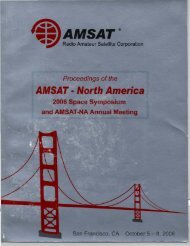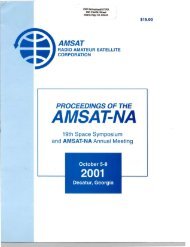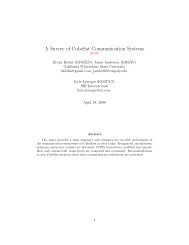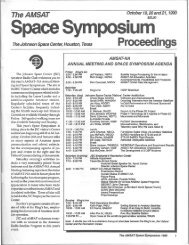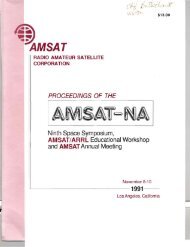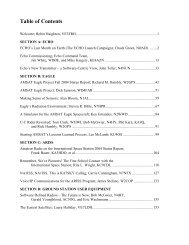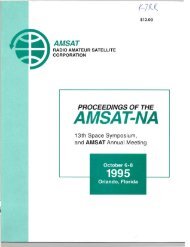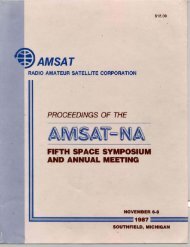October 27-29, 2000 - Klofas.com
October 27-29, 2000 - Klofas.com
October 27-29, 2000 - Klofas.com
Create successful ePaper yourself
Turn your PDF publications into a flip-book with our unique Google optimized e-Paper software.
Ed Krome K9EK<br />
Columbus, Indiana<br />
kgek@amsat.org<br />
August, <strong>2000</strong><br />
Phase 3D: A Primer on High Frequency Operatiou<br />
With the excitement over the impending launch ofPhase 3D, many people are<br />
working hard to improve existing satellite stations and add new capabilities. The AMSAT<br />
reflector is full ofdiscussions on higher frequencies, high speed digital, all kinds ofneat<br />
things! Last year, S-band (2401 MHz) downlink got a boost from the availability ofDrake<br />
2880 downconverters, readily convertible to amateur service. I expect that S-band<br />
downlink will be a very popular band, indeed.<br />
The lower bands are all pretty well known. Even 1269 MHz uplink is much less<br />
exotic than it used to be, with the availability ofplug-in modules for popular satellite<br />
transceivers. The higher bands haven't had much discussion yet; uplinks on 240112446<br />
MHz and 5668 MHz and downlinks on 10450 and 24050 MHz have great possibilities.<br />
As a long time high-frequency experimenter and general AMSAT enthusiast, these bands<br />
are ofgreat interest to me. This article will discuss some ofthe basics ofhigher frequency<br />
operation and discuss one man's approaches to operation on these frequencies. This is not<br />
supposed to be a construction article, though everything discussed has been built (and<br />
even works!), but rather to take some ofthe mystery out ofthings.<br />
Where to start<br />
Lesson one is that the sensible place to start is the one that costs you the least<br />
time, effort and money. The fact is that UHF receiving is a LOT cheaper and easier than<br />
transmitting. And the lower the frequency, the cheaper and more available the gear.<br />
Currently, 23 cm is the highest band supported by off-the-shelf ham gear, and that is an<br />
uplink-only band. For 13 cm and above, equipment shifts from one-piece boxes to<br />
distributed <strong>com</strong>ponents. A fact ofphysics says that the higher the frequency, the greater<br />
signal loss in a piece of feedline. To a receiver, feedline loss looks like increased noise.<br />
And low front end noise is the most important part of a receiving system. The most<br />
practical method ofreducing feedline loss is to eliminate the line. We do this by<br />
mounting preamplifiers (and sometimes even whole converters) directly at the antenna.<br />
Since a 13cm downlink was active on A013, this mode has already been well<br />
documented. A good reference, also useful on all higher bands, is "Mode S: The Book"<br />
available from AMSAT.<br />
Higher yet<br />
The next downlink band beyond 13 cm is 3 cm .... quite a jump in frequency and<br />
<strong>com</strong>plexity. Phase 3D has 2 separate antennas and amplifiers on 10450; one ofthem a 60<br />
watt TWTA (Traveling Wave Tube Amplifier), the other a 10 watt solid-state amplifier.<br />
These should provide a booming signal to a small dish and make this frequency very<br />
popular with both techies and even "normal" people!<br />
39



